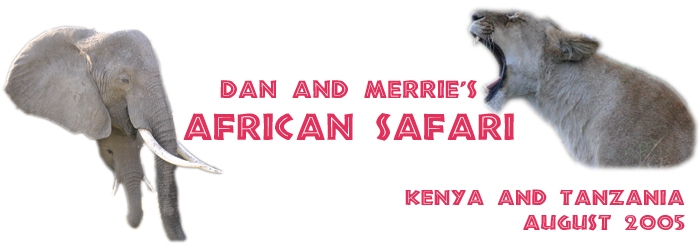|
|
Ngorongoro Crater is a retirement area for old male elephants; when they reach their sixth and final set of teeth, many elephants move to Ngorongoro Crater to enjoy the soft grasses. So all of the elephants here are male, most of them are enormous (elephants grow throughout their lives), and some of them have incredible tusks, like this guy.
|
|
|
A few zebra enjoy the miles and miles of grass available on the floor of the Crater...
|
|
|
...as do the wildebeest.
|
|
|
A grey heron is easy to pick out among the short grasses of Ngorongoro.
|
|
|
Herds of zebra and wildebeest were usually inter-mingled, here in Ngorongoro (a non-migratory herd) and elsewhere.
|
|
|
A sacred ibis gets a good look at a hippo, who is himself enjoying the muddy swamp. This is probably an old male; you can see battle scars along his back.
|
|
|
A small group of buffalo look for water in the muddy remnants of what is - during the rainy season - a flowing river.
|
|
|
A warthog gets down on his knees to forage for roots beneath the grass.
|
|
|
A Thomson's gazelle looks up to see if we're worth running from.
|
|
|
This is a black-backed jackal; we also saw golden jackals and silver-backed jackals in Ngorongoro.
|
|
|
A male ostrich enjoys his space, while a warthog - often a little skittish - starts to run away behind him. Warthogs usually run with their tails stuck up in the air like that, which made them surprisingly cute.
|
|
|
A grant's gazelle - the larger and somewhat rarer cousin of the Thomson's gazelle - grazes on the crater floor.
|
|
|
Merrie loves her safari hat.
|
|
|
A hyena wanders away across the sand. Somehow hyena always look really dramatic, as if they're about to walk across 50,000 miles of desert.
|
|
|
A helmeted guineafowl wanders around the trucks that are parks for lunch, hoping to find some crumbs.
|
|
|
Dan and Merrie stand on the shore of a small lake, with hippos in the distance.
|
|
|
A black kite flies overhead, looking to dive down and steal someone's lunch. A woman eating near us thought it would be funny to ignore everyone's good advice and hold food in the air for the enormous birds of prey. Good thinking. A bird got her food and gave her a good-sized cut on her nose.
|
|
|
The wildebeest seemed to go on forever.
|
|
|
A hippo swims away through the swamp.
|
|
|
An elephant jaw reminds us how efficient the scavengers of East Africa are. Millions of animals, and we hardly ever saw a carcass.
|
|
|
The remains of the rest of the elephant are visible in front of a herd of wildebeest, with the wall of the crater in the distance.
|
|
|
A golden jackal wanders along the road.
|
|
|
The kori bustard is the world's largest flying bird, weighing up to 40 pounds. We saw a few of them, but never saw one fly.
|
|
|
A young male lion rests on the edge of the road. His mane is still developing and he's a little smaller than full-grown. But I wouldn't mess with him.
|
|
|
An elephant enjoys a snack in the trees. A small forest occupied one corner of the generally-wide-open crater floor.
|
|
|
One of the elephants didn't seem too excited about us, and decided to chase us away. Virtually every animal we saw couldn't care less about people, but once in a while you find an elephant with an attitude. Since he's quite old, it's likely he remembers times when poachers were un-checked in Tanzania and that he has a well-founded fear of humans.
|
|
|
Merrie poses with some vervet monkeys.
|
|
|
A cheetah jogs across the plain.
|
|
|
Here we're on our way out of Ngorongoro, on our way to Serengeti, and we look down on the crater floor from the crater rim.
|


